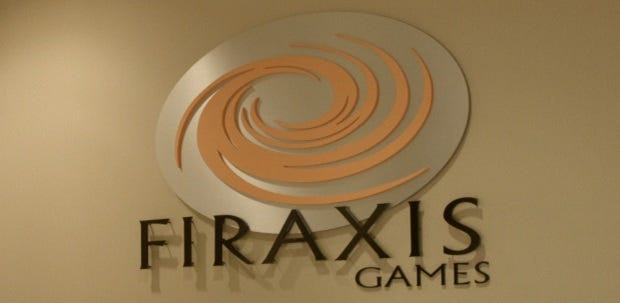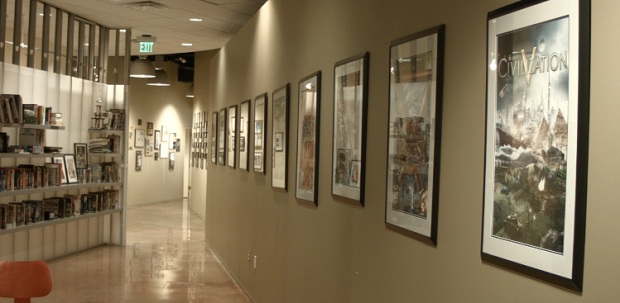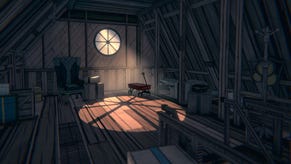Beyond Civilization: Discovering Firaxis
Of Civilization and its contents
While visiting Firaxis to play Civilization: Beyond Earth, I spent a couple of hours talking to members of the team and learning how the company works. As the current creators and curators of two of my favourite series of games, Firaxis rank among the most interesting studios in existence, and their history is also a large part of the history of PC strategy gaming. With one eye on the future and the other on the past, here are extended thougts on the utilitarian nature of Civilization, the role of Sid Meier and much much more.
If Sid Meier were an element in one of the Civilization games that carry his name, would he be a unit with stats and a specific function, or would he be one of the animated talking figureheads that represent each nation? I spent a day at the strategy studio last week, playing Beyond Earth and talking to the team working on the next iteration of Civ. During down-time, I peered at an ongoing game of Mansions of Madness in the ‘funzone’ (ping pong, table football, lots of boardgames, adjacent gym), and sat down for lunch with Meier and XCOM designer Jake Solomon.
Meier broke the ice by sharing some thoughts about the World Cup, which had ended with a much-deserved German triumph the day before. He approached the topic as an American and as a designer of rule systems – “here’s what I’d change in soccer”. The latter aspect seemed like a performance, albeit one that came very naturally, an appeal to the expectations of the assembled writers. It makes sense that Meier’s ‘hello’ is a conversation about the mechanics of play.
He and Solomon are a good double act. Jake introduces his boss as ‘an up and coming designer with a bright future’ and holds the door for him as they return to work, ‘After you, my liege’. Then, as an aside to the audience, ‘We have to call him that’. Behind the comfortable rapport there is mutual respect. Their path through the industry may have been very different in some ways, but Solomon and Meier have one important factor in common.
As with several other designers at Firaxis, both Solomon and Meier are engineers as well as one-person thinktanks. The ability to translate ideas into code without calling in technical support or gathering a team is important. “Being an engineer means you can fail quickly and privately,” says Solomon, to a nod of approval from Meier who tells us he has a computer packed with prototypes that he sifts through every now and again.
Given how much experimentation Solomon and Meier claim is possible with their skillsets, it seems slightly odd that Firaxis’ core releases are the long-running Civ franchise and XCOM, a reboot. Do so many ideas really end up on the cutting room floor? Later in the day, Civ producer Dennis Shirk mentions Meier’s 33/33/33 design philosophy. “With the Civ series, we work to Sid’s 33% rule. Each new version should be 33% new, 33% improvements and 33% retained from the previous game. With Civ V, we used almost the entire 33% new on one-unit stacks and hexes.” The expansions allowed some of the ‘old’ to be integrated into the new systems.
It’s telling that Shirk describes the 33% idea as a ‘rule’ and I think it helps to explain why so many ideas and prototypes never become games. Meier’s approach to design is strongly iterative and Firaxis reflects that. Many prototypes might contain a single concept or mechanic that makes it way into an expansion like Gods And Kings or Enemy Within. Before the two DLC packs were released, Civ V was sparse in relation to its predecessor, and that’s at least partly because every new system had to slot into a clear role within the grand design.
Civ V has a clear flow now, with fleshed out mid- and end-game systems, and Shirk admits that it represented something of a change in direction for the series. I’ve always argued that it has the feel of a boardgame, with rules, abilities and interactions that would translate well to tabletop. The mechanics of the game are manageable and relatively simple to parse. “We’re a strategy game, not a simulation. This isn’t Crusader Kings,” says Shirk.
It makes sense that Civilization is about progress and working toward an end-point. The series is about the culmination of six thousand years of human activity. Cities are factories, producing science, culture, gold and units. Improvements provide productivity boosts and the awe of a Wonder translates into a meaningful output. The civilisations of Firaxis are utilitarian, even when they do not appear to be. Your Aztec empire may prefer the beakers of science to the hammers of industry, but everything is a resource working toward a specific goal.
Civilization is – and always has been – a game about filling bars, whether those bars happen to represent the contents of a granary, a militant production queue or a utopian win condition. Even when the visual representation of the world that the numbers informed was crude, the sense of accomplishment was a strong enough engine to drive progress. Maps become busy with evidence of human achievement and borders bubble against one another, colours clashing like a layer of petrol spreading across the liquid surface of the world.
Combustible. The world rarely burns in Civ though, at least not the way I tend to play. Enter Beyond Earth, a game that begins on a world that boils with potentially hostile alien life, from larvae to behemoths. Co-designers Will Miller and Dave McDonough are a very different duo to Solomon and Meier. They’ve known each other for years and when I ask how they came to be designing the next game in such a venerable series together, the answer involves a short academic biography.
They were students together at the Savannah College of Art and Design, but when Miller wound up at Firaxis working on XCOM: Enemy Unknown he had no idea that he’d be re-united with McDonough at the company. As the latter describes it, his job application coincided with a visit to the area rather than a grand plan - a whim that has placed him in an enviable creative position.
At one point during our interview, a metaphor weaves its way into the conversation. McDonough describes his approach to design as that of a machinist, analysing and breaking down components to see what makes them tick. Reconfiguring them so that they are more efficient or capable of working with other parts of the process. “If Civ V was a car, we’d be removing and reworking most of the moving parts but retaining the chassis,” he finishes the thought.
When interviewing the two co-leads on a project, it’s tempting to split traits between them. McDonough’s machine talk places him in the engineering camp, which means I look to Miller for the broader ideas – the raw material that becomes those moving parts. For a while, he complies to my crude view. “A lot of the units in the game are inspired by the space race. We wanted to capture the romance of that period and those first steps.”
As well as historical influence, there are of course science fiction foundations. “Every book that Brian Reynolds’ cited as an influence on Alpha Centauri, we read. And then more. A lot more.” Miller isn’t shy of drawing attention to allusions and refers to Firaxis as a studio that “promotes the presence of outside culture”. As in culture from outside the office, the specific series in development, the company’s own history, digital games, boardgames and anything else within the bubble.
“There’s a lot of actual science in the game as well,” Miller continues. “The technology is based on existing ideas.” Some is theoretical, of course, and I’m glad that’s the case when it comes to the post-human ideas in particular. I suggest that with Enemy Within and some of the more brutal end-points of Beyond Earth, Firaxis are causing me to fear the future. “We’re excited by human potential but we don’t ignore the dark side. The game is about asking the question, ‘what will humanity become?’”
To answer that question, players will have to tame or neutralise the planet and its native lifeforms. I put the question to Shirk, the lead duo and systems designer Anton Strenger – will Beyond Earth force me to adapt my playstyle? I tell them that I’m normally a pacifist in Civ.
“We want players to be comfortable with their usual playstyles but they’ll find that some things don’t work precisely how they have previously.” Says Shirk. “Strategies will need to be adapted.” With Strenger, I take a more direct approach. “Will the game mess with Civ veterans’ heads?” He finds a diplomatic phrase that I take as a ‘yes’. “We use familiar systems in ways that are occasionally unfamiliar, and when we introduce a rule we often break it later in the game.”
A good example of the latter is the Rocktopus, a unit that exists on the orbital layer. Mostly, objects on that layer are used to inflict a passive status on the terrain below them, spreading across an area of effect that no other orbital unit can occupy. Strenger refers to this as a ‘parallel territorial grab’. The Rocktopus, only available to players of a certain Affinity, rocks the boat, in a metaphor spectacularly ill-suited to a ‘landgrab’ taking place in a planet’s orbit.
As the name suggests, it’s a creature rather than a machine and it can shift between the orbital and planetary layers, vulnerable but capable of unleashing a powerful attack. It breaks the rules and, as per the iterative process, it’s allowed to do so because the wider ruleset is robust enough to accommodate the occasional intentional glitch.
The art team have the tricky task of ensuring that all of the rules and assets, new and old, read well on the screen. As with the teams designing systems and flow, they’re fortunate to inherit Civ V’s user interface, which is as clean and communicative as almost anything I’ve encountered in years of gaming. Arne Schmidt heads up the art department and says the biggest challenge was working with the unknown after years of recreating historical fact.
It’s the first Civ game to be quite so reliant on concept art but unlike the work that goes into the world-building and tech tree, outside influences aren't quite as visible. "We went out and looked at a bunch of stuff and tried to go away from it as much as we could. Particularly with the affinities. We didn't want people to come in and say 'oh, these guys are from the Matrix or Pacific Rim.’ that was the most challenging part of the process - trying to define those affinities and the style of their technology while keeping them away from a specific reference."
Rather than starting with the Star Destroyer, Beyond Earth’s visuals begin with the hilt of the lightsaber. “We decided to focus on infantry and their weapons, rifles, first of all. This meant we spent a lot of time on something that is extremely small in the game but the pay-off is that a concept artist can extrapolate from that into something larger." The results of the Affinity design aren’t clear in the early stages but the alien designs are promising. They present unique problems as well.
"Living resources are the trickiest to solve. Glowing rocks look enticing and we expect them to give us energy if we mine them. A pile of grubs? We think, 'is that going to eat me?' That was actually trickier in this game than in a typical Civ game. They all look potentially threatening. IF you view a group of pigs, everybody goes 'HAM!' With the grubs, we have to try and convey a less threatening posture for them."
Producer Lena Brenk recognises the difficulties of the art style, beyond the posture of grubs. "Retaining readability is vital. The colour palette is different - we got really good at mapping Earth and making sure that people know what they were seeing. This was brand new.”
Not all of the problems are new though. “In any Civ game, at turn zero, you want the screen to be interesting but that's not how busy the screen becomes. Later on, it's much busier, we need to make sure that it remains readable throughout. It should be interesting when it's relatively empty and readable when it's fully furnished."
This comment about the difference between visibility in the early stages of a campaign brings me back to one of Shirk’s key points. “Most testing covers the opening of the game, simply because it takes so much time to play through to the end-game.” Shirk reckons that’s one reason why Civ V’s expansions moved into those later stages and overhauled them by adding points of interest. The systems, like the visuals, become busier but the player shouldn’t become overwhelmed because the process is gradual.
Strenger neatly encapsulates the difference in approach to systems in the new game. “Beyond Earth is busier from the very beginning. New systems are introduced later on but there are more things available from turn one, which allows us to build on those systems rather than simply introducing new ones.” Not all of Civ V’s features have survived the transition – Strenger says religion went through several wardrobe changes before being dropped - but the ones that are there will grow along with each campaign.
The art director’s approach ties back to the producer’s thoughts, which run back through to the systems and that iterative approach that, many paragraphs ago, I assigned to Meier. I’ve often thought of the Civ series as slightly conservative from a design perspective and there does seem to be some truth in that. Ideas that were first put into play almost twenty five years ago are still an integral part of the machinery.
Speaking to the team, however, there’s no sense of clinging onto the past. There’s a respect for what works but Miller and McDonagh are excited about the future. Civ is the vehicle that will take them there but any parts that need to be scrapped won’t make the trip, and if those outside influences can be repurposed, they’ll have a place as well.
The two lead designers don’t fit into the boxes I tried to build for them. Miller is as much the machinist as McDonagh is the dreamer. Like Meier and Solomon, they’re both thinkers and doers, designers and engineers. And that, perhaps, brings me closer to answering the question that I posed at the start of this article - what is Sid Meier’s role at Firaxis?
I think that in some ways he’s a model for many of the other employees. As large as the company has become – in terms of resources and sales – it’s still a place where two relatively junior employees can lead a team working on a flagship series. It’s a place where people can participate in company-wide gamejams that might contain the latest Sid Meier prototype alongside twenty or thirty other ideas.
Meier’s importance to Firaxis might well be down to the fact that he’s part of a pool of talent rather than the lifeguard. He certainly doesn’t seem like a figurehead, despite his name having become a brand. Like everyone else, perhaps he’s simply gathering resources, filling up the bars and waiting for the next breakthrough.
My thoughts on Civ: Beyond Earth, which is out on October 24th, are here


















